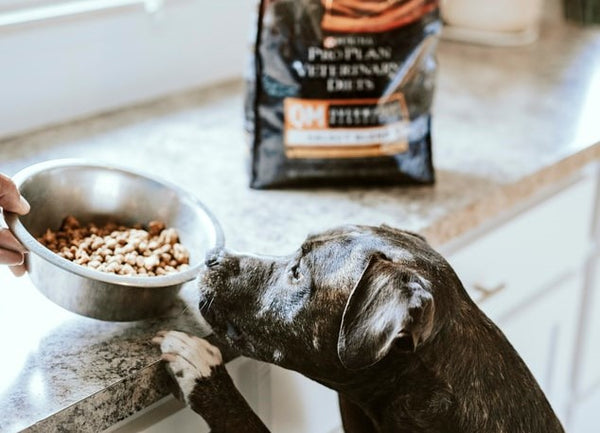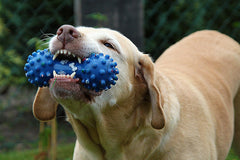
While changing to a healthier diet may be simple for us humans, switching our pup's regular kibble isn't. When our dogs start showing these signs, it's probably time to choose a new kibble to improve their quality of life:
Scratching

Pups can develop a reaction to an ingredient, even if they’ve eaten it for years. And... itchy, dry skin is one of the most common signs of allergies in dogs. Check-in with your vet for persistent scratching to get an official recommendation.
Dull Coat

Keeping your pup’s skin and coat in tip-top condition requires a diet right in essential fatty acids. And while you can supplement Omega-3’s & 6’s in their food, it's important to first look at the ingredient label. Make sure the kibble dog food is of high-quality and high-protein.
Smelly Poop & Doggy Flatulence

When it comes to smelly poop or gas, think of it like this: The more the digestive tract bacteria have to work, the more sulfur is produced by the bacteria. The more sulfur builds up, the smellier the poop. An inability to digest happens more frequently with low-quality foods. Avoid basic kibble high in filler ingredients and lactose.
Solid, smaller, and less often poops will occur when your dog is receiving high-quality, nutrient-dense food.
For one reason or another, you are preparing to transition your dog’s kibble from one brand or type to a new one. Your dog’s vet may be recommending you make this switch due to a newly discovered allergy or other known medical problem your dog has been facing.
Other reasons to switch your dog’s food may include cost reduction or just simply the fact that you’ve noticed they aren’t very fond of whatever food you’ve been feeding them.
Low Energy or Lethargic

Supporting your dogs fit and active life starts with their food. Ensure the food (and portion size) gives them sufficient nutrients by researching the quality of food... or monitoring how your dog is processing the ingredients. But, as always, be sure to check in with your vet before making a change to make sure it’s nothing more serious.
Difficulty Maintaining Weight

Too much food intake or non-satiating filler foods can cause your pup to pack on the pounds. On the other hand, dogs who are underweight may not be eating real dog food simply due to taste or inability to digest the food sufficiently. In both cases, work with your vet to first identify if the issue is food-based... then identify the right food and serving size for your pup.
If your veterinarian does think it’s due to a food sensitivity, they’ll likely suggest changing food first. Many dogs have problems with ingredients like corn, wheat, or soy. So, when looking for new food, look for labels that avoid dairy, eggs, soy, gluten, corn, and grain. Then, look for plenty of protein (above 30%), healthy fats (15-20%), and quality sourced ingredients.
Don’t Forget to Transition Slowly

Dogs are creatures of habit. Feeding them at the same time every day makes them feel secure and will make the transition easier. NOW, no matter how excited you are (or how good the new food is), it's important to slowly transition to new food over a week. This allows for a safer transition with fewer upset stomachs or kickback from your pup.
On the first day, start by making only 10% of your pup’s food the new brand. On the second day, increase it to 20%, and so on until you’ve reached 100% new. Now that we know the signs of when our dog's food isn't working so well and how to transition to healthier, high-quality food... we can start wondering if it's the right transition. When your dog has the RIGHT food... ahhhhh... it's a great feeling. Here are a few signs your dog is eating the RIGHT food:
They've Licked the Bowl Clean

You know your pup loves his food when you can't find even a crumb left in the bowl.
No Tummy Issues!

More energy and less mystery smells as your pup walks by is a sure sign they're receiving all the nutrients needed.
How to Choose the Right Food

Each dog is different, so there is no real “gold standard” or “go-to” food, unfortunately. It’s important to take variables like your dog’s age, breed, and any health issues into consideration. Your dog’s vet can help point you in the right direction when you get started. Be sure to ask your vet for good vet-recommended food options.
First, and most importantly, you need to learn how to read pet food labels. Just like with us humans, knowing what is going into your dog’s body is super important. A good reference to use when decoding pet food labels is the Association of American Feed Control Officials’ website. There, you will find definitions for the different ingredients found on dog food labels so that you know exactly what you’re feeding your pet.
A few keywords keep an eye out for are “complete balanced diet”. Seeing these words on the pet food label will let you know that you are on the right track.
After you’ve narrowed down their food choices accordingly, it’s then just a matter of trial and error. Choosing the best new food for your active pup can be a frustrating process, but your dog will thank you for it later when they are feeling happy and healthy!
How to Safely Transition Your Dog to Their New Food

Now for the most important step in the transition process: safely switching from one food to the next! This step is so important because switching their food suddenly can lead to them dealing with an upset stomach. This may manifest as vomiting, diarrhea, or just a total lack of appetite.
A safe transition should involve you gradually switching them over a 5-7-day period. By gradually, we mean that you mix some of the new food into their old food little by little each day.
For example, day one should involve their meals consisting of 25% of the new food, and the rest being their current food. Every other day you can increase that percentage by another 25% (ex: on day 3, 50% of their food will be the new food). Continue this way and by day 7 they should be eating only the new food in their meals.
Transitioning from one food to the next this way will allow their GI tracts to become accustomed to their new food, as well as giving you time to monitor them for any adverse reactions to their new diet.
Adverse Reactions to Monitor for While Transitioning Food

You should be able to tell when your dog is sick. A few adverse reactions that you should be mindful of when transitioning your dog to a new food include GI symptoms as well as reactions that can occur with their skin. Just like with humans, if a certain food disagrees with a dog’s system, they could react by vomiting or having diarrhea, or potentially breaking out in hives or becoming incredibly itchy.
Your dog is your best friend, and you want to make sure you’re doing everything you can to ensure they live a long, healthy life with you. Providing them with a balanced, healthy diet that their body agrees with is one of the most important steps in making that happen for them.




